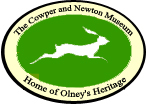|
THE MUSEUM PEOPLE
WORKS ORCHARD SIDE GARDENS |
 |
|
The Cowper and Newton Museum
|
|
The Cowper and Newton Day 2004
|
|
Forced from home and all its pleasures
Afric's coast I left forlorn To increase a stranger's treasures O'er the raging billows borne. Men from England bought and sold me, Pay'd my price in paltry gold, But though slave they have enroll'd me Minds are never to be sold. From William Cowper, 'The Negro's Complaint' (1788) An early heatwave marked the fourth Annual Cowper and Newton Day, held on Saturday 24 April. In brilliant sunshine and temperatures of up to 22 C, a record number of well over one hundred participants attended lectures, tours and exhibitions in various venues around the town. We were especially pleased that the English weather belied its overseas reputation, as this year we welcomed a party of sixteen from Pennsylvania, led by one of the main speakers for the day, Judge Tom Martin.
Tom Martin's opening lecture, intriguingly titled 'Two Curates, Two Baptists, and a Poet', outlined the history of the abolition movement and then looked at the work of five men prominent in the history of Olney who were tireless workers for the cause: John Newton (curate and former slave trader), Thomas Scott (curate from 1781-4 and noted Biblical commentator), Willam Carey (whose tracts inspired the modern missionary movement, undertaken partly in penance for Britain's involvement in the slave trade), John Sutcliffe (for 40 years Minister of Olney Baptist Church, whose vision inspired the London Anti-Slavery Committee, and who ran a seminary for the training of missionaries next his home in Olney's High Street), and William Cowper.
Professor James Walvin of the University of York - well known for his many books and articles on the history of the slave trade - followed with a fascinating examination of slavery, highlighting its crucial role in underpinning the economy of the British Empire, and concluded with an illuminating assessment of how much the slaves themselves contributed to their eventual emancipation. In the afternoon, David Johnson of the Open University complemented the earlier lectures by contrasting John Newton's narrative of his years in the slave trade (and later reflections on them) and William Cowper's campaigning poetry, with the slave autobiographies of Ottobah Cugoano and Robert Wedderburn, showing how they absorbed current ideas in philosophy, religion and politics and then applied them to their own plight.
In the early afternoon there was a choice of tours: to the parish church and churchyard, with readings by Jeremy Cooper from Newton's letters and diary; to the Old Vicarage, where Newton's study could be viewed by kind permission of the owners, Mary and John Wallace; and to the Museum, where visitors were able to see a special exhibition on slavery and abolition, as well as the recent improvements to the facilities, the newly acquired facsimile portrait of Mary Unwin by Arthur Devis, and the gardens at their Springtime best.
In the evening, the now-traditional sherry reception and dinner took place in the Olney Centre. Melon with berries and jus, rack of lamb, and berry tart were enjoyed by all including our American visitors, bravely fighting jetlag at the end of a long day. Over coffee, Tony Seward provided some after-dinner light relief by evoking the 1783-4 craze for hot-air ballooning and Cowper's bemused reaction to it in his letters. All photos © J.C.S.Pople |
|
|






